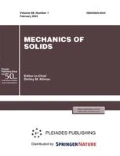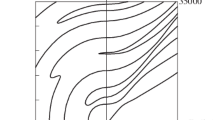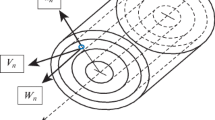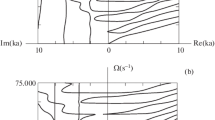Abstract—
Novel approximate methods of wave propagation analysis are developed for functionally graded cylinders with mass and elastic parameters described by continuously differentiable functions of radius. Two of these methods relate to embedding of boundary value problems into corresponding initial value problems and the third method demonstrates methodology of discretization of the physical parameters over cylinder’s cross-section. Frequency spectra diagrams of dilatational and shear waves are plotted for travelling and evanescent regimes. Diagrams of phase and group velocities are plotted for dilatational travelling waves.
Similar content being viewed by others
REFERENCES
K. F. Graff, Wave Motion in Elastic Solids (Dover Publications, New York, 1991).
A. C. Eringen and E. S. Suhubi, Elastodynamics. Volume II: Linear Theory (Academic Press Inc., New York, 1975).
L. Elmaimouni, J. E. Lefebvre, T. Gryba, and V. Zhang, “Acoustic wave propagation in fuctionally graded material (FGM) cylinders,” in Proceedings of the CFA/DAGA’04, Strasbourg, 22-25 March, 2004 (Strasbourg, 2004), pp. 1199–1200.
L. Elmaimouni, J. E. Lefebvre, V. Zhang, and T. Gryba, “A polynomial approach to the analysis of guided waves in anisotropic cylinders of infinite length,” Wave Motion 42, 177–189 (2005). https://doi.org/10.1016/j.wavemoti.2005.01.005
V. Giurgiutiu and M. F. Haider, “Propagating, evanescent, and complex wavenumber guided waves in high-performance composites,” Materials 12, 269–299 (2019). https://doi.org/10.3390/ma12020269
M. Dorduncu, M. K. Aparak, and H. P. Cheruuri, “Elastic wave propagation in functionally graded circular cylinders,” Composites, Part B 73, 35–48 (2015). https://doi.org/10.1016/j.compositesb.2012.05.043
S. M. Hosseini, “Analysis of elastic wave propagation in a functionally graded thick hollow cylinder using a hybrid mesh-free method,” Eng. Anal. Bound. Elem. 36 (11), 1536–1545 (2012). https://doi.org/10.1016/j.enganabound.2012.05.001
C. Hu and Z. Yu, “Numerical simulation of elastic wave propagation in functionally graded cylinders using time-domain spectral finite element method,” Adv. Mech. Eng. 9 (11), 1–17 (2017).
Y. O. Yang, C. Liang, and J. W. Zu, “Wave propagation in functionally graded cylindrical nanoshels based on nonlocal Flugge shell theory,” Eur. Phys. J. Plus 134, 233 (2019). https://doi.org/10.1140/epjp/i2019-12543-0
M. Shatalov, E. V. Murashkin, E. T. Akinlabi, et al., “Axisymmetric wave propagation in functionally graded cylinder with isotropic concentric layers,” Mech. Solids 55, (4), 595–605 (2020). https://doi.org/10.3103/S0025654420040135
W. H. Press, S. A. Teukolsky, W.T . Vetterling, and B. P. Flannery, Numerical Recipes, 3rd ed. (Cambridge Univ. Press, Cambridge, 2007).
Funding
The work was financially supported by SA (NRF)/RUSSIA (RFBR) joint science and technology research collaboration (project No. 19-51-60001).
Author information
Authors and Affiliations
Corresponding authors
APPENDIX
APPENDIX
System of axisymmetric dilatational vibration of cylinder with radial dependence of its physical (mass density and elastic) parameters is as follows:
where \(u = u\left( {t,r,z} \right)\), \({v} = 0\), \(w = w\left( {t,r,z} \right)\) are the radial and axial displacements correspondingly, t is time, r is radial coordinate and z is axial coordinate; ρ(r) is mass density; \({{\sigma }_{{rr}}}\), \({{\sigma }_{{\theta \theta }}}\), \({{\sigma }_{{zz}}}\), \({{\sigma }_{{rz}}}\) are stresses which are linearly dependent on strains due to Hook’s law:
where \(\lambda \left( r \right)\), \(\mu \left( r \right)\) are Lame’s elastic factors and \({{\varepsilon }_{{rr}}} = {{\varepsilon }_{{rr}}}\left( {t,r,z} \right)\), \({{\varepsilon }_{{\theta \theta }}} = {{\varepsilon }_{{\theta \theta }}}\left( {t,r,z} \right)\), \({{\varepsilon }_{{zz}}} = {{\varepsilon }_{{zz}}}\left( {t,r,z} \right)\), \({{\varepsilon }_{{rz}}} = {{\varepsilon }_{{rz}}}\left( {t,r,z} \right)\) are linearized strains:
Substituting (A.2) in (A.1), we obtain the following we obtain the following system of axisymmetric dilatational vibration of the cylinder:
In the case of axisymmetric torsional vibration, the governing equation is:
where \({v} = {v}\left( {t,r,z} \right)\), \(u = w = 0\), and stresses are:
where strains are:
Substituting (A.7) in (A.6) and further in (A.5), we obtain the following equation of axisymmetric shear vibration of the cylinder:
About this article
Cite this article
Shatalov, M., Murashkin, E., Mahamood, R. et al. AXISYMMETRIC WAVE PROPAGATION IN FUNCTIONALLY GRADE CYLINDER WITH SMOOTH RADIAL DISTRIBUTION OF PHYSICAL PARAMETERS. Mech. Solids 56, 571–585 (2021). https://doi.org/10.3103/S0025654421040154
Received:
Revised:
Accepted:
Published:
Issue Date:
DOI: https://doi.org/10.3103/S0025654421040154




